Ancient Aliens on the Moon (18 page)
Read Ancient Aliens on the Moon Online
Authors: Mike Bara

Supporting substructure of a radio telescope here on Earth.
Somewhat less distinct (because it is also somewhat farther away from the camera) but still impressive is the crater Proclus. Located just to the east of the Crisium basin at 16.1°N/46.8°E, Proclus is considered a fairly run-of-the-mill impact crater. Still, it has an unusual hexagonal shape and an extensive ray system emanating from it. Next to Aristarchus, it is the brightest crater on the Moon.
It is also one of the most colorful. Using techniques similar to the ones we discussed in the last chapter, amateur astronomers have captured the true colors of Proclus and the entire Crisium region quite successfully. Again, these color tone variations can only be explained by the presence of a glass-like medium bending and scattering light all over the lunar surface, creating multicolored hues and all of the various tones in between. It implies that the entire Crisium basin lies beneath an extensive lattice work of glass structures.
But what makes Proclus stand out in AS16-121-19438 is its incredible resemblance—just like Asada—to a radio telescope or satellite dish. As we zoom up on it, even though the haze that astronaut Al Worden talked about, we can see that it has at least six regularly spaced support struts jutting out underneath it. Also visible are the regularly spaced dark gaps in between the struts, where it appears that access could be gained to whatever lies underneath the “crater.” While it is true that very few images of Proclus show what we see here, this is the most oblique angle of the crater we have, giving us a rare side-on look at the formation.
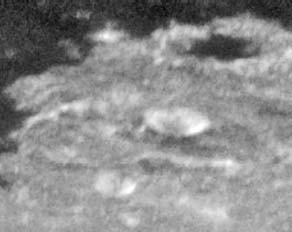
Crater Proclus from NASA frame AS16-121-19438.
And it looks like a satellite dish.
A quick side-by-side comparison of Asada and Proclus shows that we aren’t simply seeing things. Both objects look exactly like you’d expect a radio telescope to look edge on and from a distance. Yet there are still some mysteries of the Mare Crisium region that remain unresolved.
In an effort to confirm these findings, I took to the web to find the latest high resolution scans of both NASA frames AS16-121-19438, and the more oblique AS10-30-4421. But what was found only deepened the mystery. In doing a side-by-side comparison of the version of AS16-121-19438 that I had obtained through Richard C. Hoagland to the one I had downloaded from the NASA official sites, I began to notice some very disturbing differences. For one thing, the Spire wasn’t there.
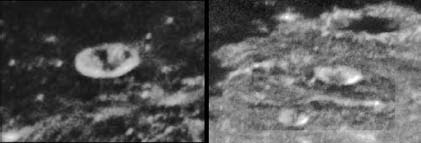
Asada and Proclus side-by-side.
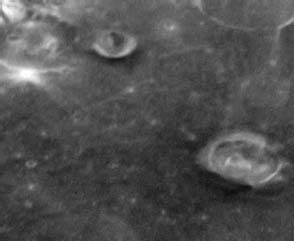
Official version of AS16-121-19438 with Spire optically removed.
It was gone. Completely whitewashed. The wispy support wires are still somewhat visible, but the “Spire” itself has been completely and effectively removed. A quick comparison shows that in the officially released NASA version, the Spire simply ceases to exist.
Other features, like Asada and Proclus, seem to hold up better. They both retain their satellite dish characteristics and in fact some features can even be seen more clearly than in the official NASA scans.
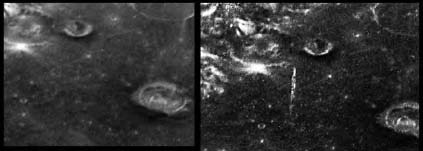
Apollo 16 frame AS16-121-19438 . (Left) and Hoagland (Right).
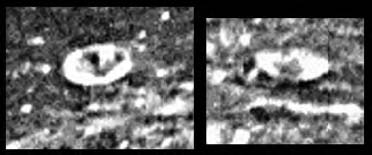
Craters Asada and Proclus from the Hoagland version of AS16-121-19438.
These discrepancies raise an interesting question. What if the Spire hadn’t been digitally white washed from the official NASA version of frame AS16-121-19438? What if they weren’t actually two different versions of the same photo, but rather two different photos altogether, both filed under the same official NASA frame number? Remember the 4822 Lunar Orbiter image of Sinus Medii? What if this was the same kind of skullduggery at work?
In order to clarify the possibilities here, a quick review of just where Richard C. Hoagland got his copy of AS16-121-19438 is worth repeating. As we told the story in
Dark Mission
, the image was obtained by a very lucky turn of events:
“The ‘source’ was well-known to NASA and (according to his account), ‘regularly visited’ at NASA Headquarters. He had been there, in the Administrator’s office, a few days after Apollo 16 returned to Earth from its successful visit to ‘the highlands of the Moon’—April 27, 1972. For some reason he was left alone in the Administrators office between meetings; he looked over and saw a massive bunch of Apollo photographs lying on the Administrator’s desk. Bored, he casually leafed through a few… and was shocked by what he saw.
On impulse (he said later…) he quickly slipped one of the prints into his briefcase and—before the Administrator could return— abruptly left.”
23 years later, this same anonymous source handed Hoagland the version of AS16-121-19438 which contains the Spire and numerous other anomalies. It is truly a sad state of affairs when a member of the American public is forced to get the true story of what is on the Moon by swiping a picture off the NASA administrators’ desk as opposed to simply having NASA reveal the truth themselves. But, such is the post Brookings world we live in.
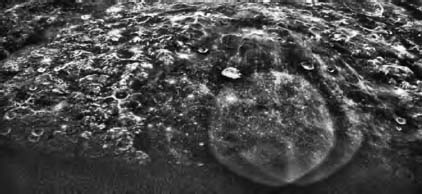
Lunacognita enhancement of the NASA version of AS16-121-19438.
That said, there is still quite a bit to be learned from the “official,” sanitized version of the photograph. Some other intrepid anomaly hunters have been doing just that.
Although the official version of AS16-121-19438 is quite a bit blurrier and seems to have a significant amount of digital noise introduced into it, it is still useful for some research. A group calling itself Lunacognita has done some excellent enhancements of the photo and what it shows is not only revealing, but it is consistent with what we have already observed on the “Hoagland” version of the frame.
In all three of their enhancements, the obscuring medium in the lower part of the image is very clear, and it is obvious that there is something between the camera and the lunar landscape below, just as we see in the Hoagland and official versions. This all but confirms that the blurriness in both images is caused by something physical and is not a camera anomaly. In another enhancement, we can see the shattered remnants of this massive glass scaffolding high above the Crisium plane in the sky beyond. This indicates that the actual photo is shot down through a hole in the overall structure of the scaffolding, possibly punched there by thousands and thousands of impacts over the millennia.
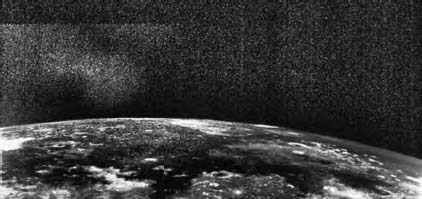
(Lunacognita)
What these independent images show is that there is ample evidence for the theorized glass towers over Mare Crisium. We have several TLP observations over a couple of centuries at least, Earth based telescopic observations which show the multi-colored lunar surface as rays of light are bent, refracted and combined by the many panes of this glass structure. We have a NASA original photo—taken from the desk of the NASA administrator back in the 1960s—which shows an obscuring medium between the camera in orbit and the lunar surface below. We have a crystal clear image of a structural “Spire” supported by “guy wires” at 90-degree angles to it. We have a pie shaped portion of a former dome over the crater Picard. We have an oblique view of Picard that shows the dark, bent over supports of the dome that once encased the crater. And we have at least two craters which have underlying support structures and look more like satellite dishes than impact craters. We have an independent confirmation of a gauzy, haze-like blanket that one of the Apollo astronauts testified that he was looking down through to the Crisium basin below, which is entirely consistent with our model of a transparent superstructure over the Crisium basin. We have independent confirmation of the towering glass structures over Mare Crisium against a sky that should be absolute black. Structures, by the way, that are completely consistent with what we’ve already confirmed are over Sinus Medii. Did I miss anything?
